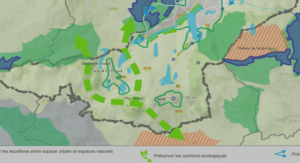Dans les climats tempérés froids, l’hiver est souvent perçu comme une période d’accalmie pour les systèmes fluviaux. Les chenaux sont couverts d’ une couche de glace qui paralyse en apparence l’activité fluviale . Or, la période hivernale engage un enchaînement de nouveaux processus et de formes qui modifient en profondeur les interactions dans le système fluvial (Allard et al., 2009). Le couvert de glace est un volume solide qui confine l’écoulement dans un conduit fermé. L’envers du couvert de glace est souvent moins lisse qu’il n’y paraît sur la surface et peut présenter des microformes profilées à l’image des rides sableuses ou des aspérités liées à la fusion de la glace (figure la). La présence d’ un couvert de glace plus ou moins rugueux ralentit l’écoulement en surface et forme un second gradient de vitesse. En conséquence, l’écoulement sous glace est caractérisé par deux couches-limites turbulentes , l’une propre au lit (CLT,) et une seconde liée à la glace (CLTg) . L’impact de cette structure de l’écoulement dans la nature des échanges turbulents en milieu fluvial reste toutefois largement inexploré.
Depuis la deuxième moitié du XXèrne siècle, des structures cohérentes de fluide avec des cycles de vie quasi-périodiques ont été observées dans des écoulements en laboratoire et en rivière. Parmi elles, on distingue celles dites macroturbulentes dont la taille est proportionnelle à la profondeur de l’écoulement. Ce sont des échanges cohérents de fluide qui, en rivière de petite et moyenne tailles, dominent la totalité de la tranche de l’écoulement. Pendant la période hivernale, l’interaction de l’écoulement avec la rugosité glacielle produit une nouvelle source de turbulence. Cette turbulence est associée à des échanges cohérents émanant du couvert de glace qui se propagent dans l’écoulement et se mélangent aux structures en provenance du lit. L’effet de cette double CLT sur l’occurrence des échanges macroturbulents est inconnu. Cette méconnaissance provient autant d’ un manque d’acquis sur les mécanismes spécifiques à la formation des structures macroturbulentes qu’à une absence d’étude portant spécifiquement sur cette échelle.
À l’échelle des tronçons fluviaux, les échanges turbulents se traduisent par des patrons tridimensionnels complexes. Le patron spatial des écoulements secondaires dans les méandres à surface libre est bien connu et se résume grossièrement à la présence d’une cellule de rotation hélicoïdale (Blanckaert et Graf, 2001; Frothingham et Rhoads, 2003). Ce schéma conceptuel est toutefois inapplicable aux conditions englacées en raison de la nouvelle structure de la CLT. Des études en laboratoire ont montré que le patron spatial des écoulements dans les chenaux curvilinéaires avec couvert de glace présentent deux cellules hélicoïdales superposées et de sens de rotation inverse (Zufelt, 1988; Urroz et Ettema, 1994). Toutefois, les simulations en laboratoire simplifient les conditions naturelles caractérisées par une morphologie complexe et l’effet potentiel des accumulations de frasil sous le couvert. Les accumulations de frasil sont courantes pendant la période hivernale et peuvent générer des obstructions m<üeures à l’écoulement. La constriction des écoulements peut même être suffisante pour générer la mobilisation des sédiments et modifier les formes du lit (Sui et al., 2008).
Cette étude se base sur un échantillonnage du champ de vitesses dans un méandre de la rivière Neigette, située en périphérie de la ville de Rimouski (Québec, Canada). Les mesures de vitesses ont été obtenues à l’aide d’un profileur acoustique à effet Doppler (PC-ADP). Celui-ci mesure des séries temporelles de vitesses simultanément sur l’ensemble de la profondeur et dans les trois dimensions de l’espace. C’est un instrument non-intrusif adapté aux rivières peu profondes et suffisamment robuste pour résister aux températures hivernales. Les capacités du PC-ADP offrent une opportunité unique pour l’étude des structures macroturbulentes dans l’écoulement sans a voir recours à une série de sondes ponctuelles intrusives, donc plus délicates à déployer sous un couvert de glace en rivière. Aussi, cette simultanéité dans l’acquisition des séries temporelles accélère la collecte de données et permet de reconstituer le champ tridimensionnel des vitesses d’écoulement à l’échelle d’un tronçon fluvial en relativement peu de temps. Trois campagnes de terrain ont eu lieu, deux pendant les hivers 2007 et 2008 et une pendant l’été 2007, ce qui a permis l’acquisition de plus d’une centaine de profils de vitesses. Pendant l’hiver 2007, le méandre était occupé par une quantité importante de frasil qui modifiait le patron des écoulements dans le méandre et empêchait localement l’acquisition des données par le PC-ADP. En 2008, le frasil était absent. Ce qui est apparu en premier lieu comme un obstacle majeur au projet a été en définitive exploité pour étudier l’effet des engorgements de frasil sur le patron de vitesses par une analyse comparative entre les données de l’hiver 2007 et 2008.
In coId temperate climate, the winter season is associated with particular processes and interactions between the different components of fluvial systems (Allard et al., 2009). Most notably, the formation of an ice coyer has immediate and profound impacts on the flow structure of the turbulent boundary layer (TBL). Turbulent flow structure is a fundamental mechanism in the boundary layer that acts on mixing processes, sediment transport (Lapointe, 1992; Drake et al., 1988; Cellino and Lemmin, 2004; Paiement-Paradis et al., 2011), morphological change (Leeder, 1983; Best, 1993) and aquatic habitat (Davis and Barmuta, 1989; Carling, 1992). Central to the theme of turbulent flow structure is the occunence of quasi-periodical coherent motions that promote strong exchanges between the inner and outer layers of the flow. The near-wall region, or inner layer, is a breeding ground for the production and self-sustainment of such coherent structures (Smith et al., 1991; Smith, 1996). The main structures are the upward bursting of slow fluid motion called ejections and downward inrushes of fast fluid motion called sweeps (Kline et al., 1967; Corino and Brodkey, 1969). These mechanisms contribute to most of the turbulence production (Kim et al., 1971). Grass (1971) showed that these turbulent mechanisms are present in rough turbulent wall conditions and can be scaled with the size of the roughness elements (Grass, 1971; Grass et al. 1991; Defina, 1996; Grass and Mansour-Tehrani, 1996).
The outer layer of the flow was also found to present large coherent structures that scaled with the thickness of the boundary layer. These structures are hereby refened to as macroturbulent. The outer layer flow maintains conelated velocities throughout the boundary layer with signatures similar to those of ejections and sweeps (Brown and Thomas, 1977; Nakagawa and Nezu, 1981). Large bulges of coherent fluid motions were also found to occur coincidently with altemating low and high-speed pulsations of flow compared to mean velocity (Falco, 1977). This macroturbulence was described as three-dimensional quasiperiodical vortices ‘rolling’ in stable paths of the channel (Schvidchenko and Pender, 2001). Altemating pulses of high and low speed velocities are equally present in both sand bedded (Levasseur, 1999) and gravel-bed channels (Fergus on and Kirkbride, 1995; Buffin-Bélanger et al., 2000). Roy et al. (1996) found integral time and length scales to remain constant at different flow depths, suggesting that the flow is dominated by coherent structures units occurring simultaneously over the entire flow depth. These large scale structures were found to have convex shaped fronts, forming wedges with a mean angle of 36° with the bed (Buffin-Bélanger et al., 2000). Based on space-time correlation analysis applied to simultaneous velocity time series measured in various configurations of a gravel-bed river, Roy et al. (2004) presented the shape of wedges as elongated (3 5Y) and narrow features (0.5-1 Y) where Y is flow depth. The mechanism that generates and sustains macroturbulent structures is still unclear (Robinson, 1991, Roy et al., 2004; Nezu, 2005). Macroturbulent coherent flow structures occurring in the outer layer have been presented as the result of the coalescence of ejection motions expanding throughout the boundary layer (Head and Bandyopadhyay, 1981; Perry and Chong, 1982, Nezu and Nakagawa, 1993). Amalgamation of small-scaled coherent structures from eddy shedding and wake flapping in the lee of protruding particles could also set the conditions for larger scaled structures initiation in gravel bed channels (Hardy et al., 2009). Even if the inner layer is the main provider of turbulence production, studies have also shown that large scale structures occurring in the outer layer has a prominent influence on the inner layer turbulent processes Roy and Blackwelder, 1994; Buffin-Bélanger et al. 2001).
To date, research addressing the hydraulic response to ice coyer formation has focused mainly on the mean velocity profiles. Bulk flow velocity is slowed and depth correspondingly increased as a consequence of an additional roughness boundary in the perimeter of the flow (Ashton, 1986). Often, the ice undercover presents wavy forms similar to sand bedded ripples, effectively mimicking the roughness of a channel bed (Ashton and Kennedy, 1972). The general shape of the resulting velocity profile is a more or less symmetric parabolic form with peak velocities found toward the smoother boundary. In depth-limited flow typical of small rivers, the classical perspective is to consider the flow as two boundary layers that behave like two distinct open channel flows stacked on each other and meeting at the plane of maximal velocities. Logarithmic profiles can be applied independently to both velocity gradients leading to computerization of boundary parameters (Larsen, 1969). A few flume and field studies have also examined turbulent parameters in perspective of the two boundary layer hypothese (Hanjalic and Launder, 1972; Parthasarathy and Muste, 1996, Sukhodolov et al., 1999). When applied piecewise to each boundary layer, profile trends of turbulence intensities and Reynolds shear stress are found to follow semitheoretical predictions established for open channels. Close to the ice co ver, Reynolds shear stress in the combined streamwise and vertical components of the flow show negative values. Slow upward and fast downward motions c1assically associated to coherent motions are turned upside down, leading to slow downward and fast upward motions. Thus, the plane where Reynolds shear stress crosses the O-value can be viewed as a mean interface dividing two stacked boundary layers dominated by different turbulence signature, one pertaining to the ice cover and the other to the channel bed.
The assessment of macroturbulence dynamics in the case of a composite input of turbulence production is only tentative since no measurements were designed to focus at this scale of analysis. The aims of the paper are to identify macroturbulent coherent structures in an ice covered f10w and to describe their geometry and spatial distribution in regard of the flow division in two TBL. The flow velocities are measured with a Pulse-Coherent Acoustic Doppler Profiler (PC-ADP), deployed in a small sand bedded channel with a fully developed ice cover. The PC-ADP is a non intrusive instrument that can measure profiles at a high vertical resolution simultaneously. It offers a unique opportunity to easily visualize and analyse in synchronicity the macroturbulent scale of turbulence over the entire flow depth without resorting to arrays of single point devices which would be delicate to deploy under an ice cover. The paper presents a series of analysis that follows the guidelines of c1assical techniques already used in the context of macroturbulence detection in open channel conditions (visualisation of velocity signaIs and correlation analyses) while fully exploiting the high density potential offered by the PC-ADP. The PC-ADP measurement technique and its potential in the measurement of turbulence parameters will first be reviewed since its use has yet to be widespread for the study of turbulence.
INTRODUCTION |






